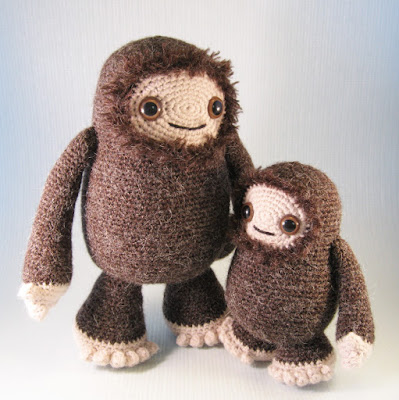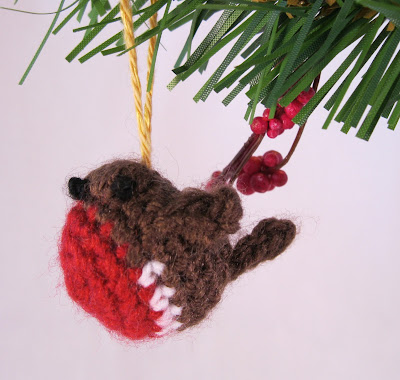I've been getting a few requests recently asking about the yarn I used to make the 12 patterns in my Star Wars book, so here are all the details. I live in the UK, so that's where I get all my yarn from. I use double knitting (DK) weight yarn, equivalent to 3:light weight in the US, and 8 ply in Australia/NZ - there's a yarn thickness guide on Ravelry which is very helpful. If you can't get hold of the yarns listed below, you can at least look at them in an online store such as Wool Warehouse, which might help you find equivalents closer to home. I used mostly Hayfield Bonus DK, including Black (965), White (961) and Fleshtone (963) for many of the characters. Here's the list of the yarn used for each character individually, not including black, white and skin colour yarn: Boba Fett: Hayfield Bonus DK, Orchard (904), Rustic Red (891), Dark Grey Mix (790), Light Grey Mix (814), Pumpkin (766), Robin DK Rust (26)
C-3PO: Hayfield Bonus DK, wheat (816), Robin Paintbox DK, Leopardskin (197) (possible alternative for gold, Hayfield Bonus DK, Pumpkin (766))
Chewbacca: Hayfield DK with wool, brogue (92) for the darker colour, and Hayfield Bonus DK , walnut (927) for the lighter colour. Bandolier, Hayfield Bonus DK Copper (843) and Light Grey Mix (814)
Darth Vader: Hayfield Bonus DK, Light Grey Mix (814), Emerald (916), Signal Red (977) or Classic Red (833), Dark Grey Mix (790)
Wicket the Ewok: Hayfield DK with wool, brogue (92) and Hayfield Bonus DK Copper (843) and Oatmeal (964)
Han Solo: Hayfield Bonus DK, Chocolate Brown (947), Pine (761), Cream (812), Rustic Red (891) or Classic Red (833)
Jabba the Hutt: Hayfield Bonus DK, orchard (904) and wheat (816)
Luke Skywalker (Jedi): Hayfield Bonus DK, Wheat (816), Dark Grey Mix (790), Lightsaber, Bright Green (886) or Robin DK Cordial (162), Light Grey Mix (814)
Princess Leia: Robin DK Brown (051), Hayfield Bonus DK Light Grey Mix (814) and Rustic Red (891) or Classic Red (833)
R2-D2: Hayfield Bonus DK, Royal (979), Light Grey Mix (814) or Robin DK Silver (027)
Yoda: (note, the green I used is not available anymore, this is a possible alternative) Hayfield Bonus DK, Grass (825), Chocolate Brown (947), Oatmeal (964) or Hayfield DK with wool, Sand (091)
I know that seems like an awful lot of different yarns, but a lot of them are repeated for different characters, and I used slightly different tones of yarn where you could use the same one if you want to economise, so here are the main colours of yarn you need:
Pale Green for Yoda: Hayfield Bonus DK, Grass (825)
Green for Jabba and Boba Fett: Hayfield Bonus DK, orchard (904)
Flaxen gold/blond colour for C-3PO, Jabba's face and Luke's hair: Hayfield Bonus DK, Wheat (816)
Light Brown for Chewbacca: Hayfield Bonus DK, walnut (927)
Brown for Chewbacca and Wicket: Hayfield DK with wool, brogue (92)
Brown for Han's hair and Yoda's body: Hayfield Bonus DK, Chocolate Brown (947)
Dark Brown for Leia's hair: Robin DK Brown (051)
(You could just use the same shade of brown for Han and Leia's hair)
Two shades of grey used for many of the characters, you could just use one of them: Dark Grey Mix (790), Light Grey Mix (814)
Light Beige for Yoda's robe and Wicket's feet: Oatmeal (964) or Hayfield DK with wool, Sand (091)
Rust Brown for Wicket's hood and Chewy's bandolier: Hayfield Bonus DK Copper (843) - similar to Robin DK Rust (26) used for Boba Fett so could use either.
Royal Blue for R2-D2: Hayfield Bonus DK, Royal (979)
Dark Blue for Han's trousers: Hayfield Bonus DK, Pine (761)
Cream for Han's shirt, could substitute white: Hayfield Bonus DK, Cream (812)
Red for Boba Fett's helmet, can be used for side of Han's trousers and Leia's lips: Hayfield Bonus DK, Rustic Red (891)
Then there are a few yarns that you only need a very small amount of, such as the variegated brown yarn for C-3PO's middle (Robin Paintbox DK, Leopardskin (197)), the dark yellow on Boba Fett's costume (Hayfield Bonus DK, Pumpkin (766)), the bright red and greens used for the buttons on Darth Vader and his and Luke's lightsabers.
I hope that list is some help, just ask if you have any questions.





















































































